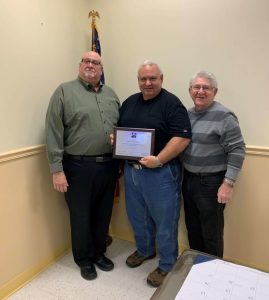AOP technology is vital in treating emerging contaminants

(Photo courtesy of the Hicksville Water District)
The Hicksville Water District (HWD) recently received an award from the American Council of Engineering Companies (ACEC) for its rapid deployment of Advanced Oxidation Process (AOP) treatment systems to fight the presence of 1,4-dioxane in some of the District’s wells, which started in the summer of 2020. H2M architects + engineers nominated the district for this annual award, recognizing the district for the exceptional job it did in rolling out this vital water treatment technology.
“Providing our residents with the cleanest water available is our chief priority at the Hicksville Water District,” HWD Chairman Karl Schweitzer said. “Our ability to successfully roll out our AOP treatment systems quickly and efficiently is a tribute to the dedication of our board of commissioners, superintendent and the rest of our incredible staff. It is an honor to receive this award from the ACEC and to be recognized for the hard work we have all put in over the last two years to keep our most precious resource safe.”
The HWD initially began piloting the AOP process in 2018 after receiving a grant from New York State as a part of its Water Infrastructure Improvement Act. The district was exceptionally aggressive in its actions to complete the piloting process, enabling them to rapidly install the new treatment systems.
AOP treatment, when coupled with granular activated carbon (GAC), is the only proven method to rid the water supply of 1,4-dioxane. This treatment combination is also capable of removing perfluorooctanoic acid (PFOA) and perfluorooctanesulfonic acid (PFOS), should detections of these contaminants ever near the State’s maximum contaminant levels (MCLs). AOP treatment works by mixing an oxidant, in this case hydrogen peroxide, with water and running it through ultraviolet light. This makes a chemical reaction that destroys the 1,4-dioxane molecules. The water then runs through the GAC filters which removes any remaining hydrogen peroxide and impurities prior to entering the public distribution system.
—Submitted by the Hicksville Water District






























